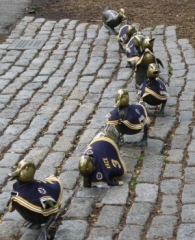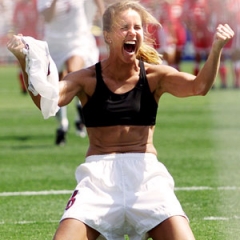The month of June provided a myriad of exciting championships for athletes and sports fans. The Dallas Mavericks beat the Miami Heat to win the NBA Championship, the Boston Bruins handily defeated the Vancouver Canucks, on Canadian ice in game 7, to bring Lord Stanley’s Cup to Beantown, and Rory McIIroy walked onto the Congressional Golf Course in Maryland and won a momentous and memorable US Open Championship. Winning by 8 strokes, McIIroy shattered numerous records and endeared the hearts of fans worldwide.
The Cup
In Boston, on the days of games 6 and 7 of the Stanley Cup final, my seven year-old daughter and I saw countless hockey fans and proud Bostonians modeling Bruin logoed apparel and waving flags and placards. The entire city railed behind the Bruins. A “Let’s Go Bruins banner” adorned the Massachusetts State Capital on Beacon Hill. The Boston Public Gardens iconic statues of General George Washington and Robert McCloskey’s ducks — Mrs. Mallard and her eight ducklings–sported Bruins jerseys with their names emblazoned on the back. The ducks were immortalized in his 1941 award-winning children’s book Make Way for the Ducklings.
Among the die-hard fans were many women with finger and toenails painted black and gold. And there were plenty who smeared face paint and hair dye enthusiastically cheering their team to victory. We too got into the championship frenzy picking up numerous Bruins placards with the words “We Want the Cup” and “There Can ‘B’ Only One” and posing in front of various landmarks along Boston’s Freedom Trail.
After the win, together we watched on television, more than one million Bruins fans line the two-mile stretch from the TD Garden, the Bruins home ice, to Copley Square for the championship parade to congratulate their team and perhaps touch the cup. Children were everywhere. This team has inspired a new generation to take to the ice.
The following day we watched Rory McIIroy’s win for the ages. On Monday morning, as I read several articles that lauded this young Irishman’s skill and focus, I thought about the last time my daughter and I watched a women’s athletic event together. We both play several sports, but are rarely spectators to such games.
The last time was back in April when Texas A&M women’s basketball team defeated Notre Dame 76-70 earning the school their first NCAA Championship.
What is broadcast
So just why is it that we watch men’s sports more than women’s? Is it because they are not broadcast as much? Is it that they are not as exciting? Are there not as many events showcasing women athletes (for instance no female pro baseball or football or hockey)?
The Wimbledon fortnight is underway and the LPGA Championship is being contested. Serena and Venus Williams have won 4 and 5 Wimbledon titles respectively. With 23 career Grand Slams, Serena has become one of the tennis’ greatest all-time players. Venus, her older sister, owns 21 Grand Slam titles, more than any other active female player, except for Serena. We have yet to tune into these two competitions.
Women’s professional basketball, soccer, and golf are struggling. In her article “Twelve years later, still the best” ESPN.com’s Johnette Howard wrote about the U.S. team that won the 1999 Women’s World Cup. She wrote:
The U.S. women’s sports movement seems to have fizzled since they moved along, which feels bittersweet. The ’99 World Cup and ’96 Atlanta Olympics (the so-called Gender Equity Games) were supposed to be a liftoff point to a ceiling-less future — more women’s pro leagues, more exposure, more of everything for women across the sports spectrum. But instead, that time now feels like it was the best it might ever get, at least for a while. The LPGA golf tour is shrinking. The WNBA is limping along in its 15th year with yet another new commissioner. The women’s tennis tour seems to obsess annually over two questions: “How are the Williams sisters doing?” and, if Venus and Serena are on one of there frequent hiatuses, “How long before they’re back?”
The first stab at a U.S. women’s pro soccer league tore through $100 million in three years and folded. The latest try, Women’s Professional Soccer (WPS), is fighting to hang on.
The 1999 US Soccer Team was the first women’s professional sports team to capture American hearts and imagination. This group of talented athletes included many whom had played together for more than a decade. In dramatic fashion in front of 90,185 screaming and face-painted fans in Pasenda, CA, the US beat China 5-4 in the penalty shoot out. It was the largest crowd to ever witness a women’s athletic competition.
The Naked Truth
Upon scoring the winning goal in this international competition, an exuberant midfielder Brandi Chastin ripped off her jersey, fell to her knees, and with clenched fists raised her arms in victory. The moment was captured in every major paper and the cover of Sports Illustrated. In that celebratory moment, an adrenaline pumped athlete at the pinnacle of her sport, revealed a ripped body and a six-pack of abdominal muscles. It is one of the most iconic photos in all of sports. And it ignited a controversy about just how much she revealed.
Women jog in sports bras everyday. Still people made a big deal out of nothing. This is what winning soccer players do (or did until after FIFA made it a yellow card penalty in July 2007). It was not the first time Chastin had disrobed. But it was the first time for many people to see because most people do not follow women’ sports. Chastin’s sports bra covered more than most bathing suits we would see at the beach…or a beach volleyball tournament.
Time and Newsweek put this U.S. team on their covers. Some journalists declared them the pop culture story of the year. Across the nation, young girls took to the fields kicking balls and wanting to be like Mia Hamm, Michelle Akers, Kristin Lilly, Julie Foudy, Brandi Chastain, Briana Scurry, Carla Overbeck and Joy Fawcett.
Watch a Game
On Sunday Jun 26, the 2011 FIFA Women’s World Cup commences in Germany. As expected, the quadrennial event is getting little media coverage in the States. USA Today ran a page length article on the back cover of its sports section on June 23. Friday’s Wall Street Journal published, “It’s Germany’s Cup to Lose” and ESPN has aired a few commercials in between the NBA draft.
During two weeks, I encourage you to take the time to watch a few of the women’s world cup games with your daughters and sons. ESPN and ESPN2 are broadcasting the games.
If our women’s team wins the World Cup again, that might give another professional soccer a boost. But, it’s going to be tough. One big problem is while women have no problem wearing replica jerseys of male pro athletes, men have a problem wearing the jersey of a top-flight female pro athlete.



Over the weekend, I thought about why men don’t watch women’s sports. Here are a few of my thoughts:
1. Men like gladiators who are the biggest, fastest, strongest, and meanest. Speaking strictly for myself, I cannot watch the WNBA, for example, because women–despite their tremendous skills– can’t be the biggest, strongest, fastest, and dunking-est.
2. Women are the fairer sex. Men think of women as beautiful, sexy, cute. That’s why women’s beach volleyball works. On the occasions that I watch, it’s because of the babes in bikinis. The women who crossover in sports have a high babe-appeal-index, i.e. Anna Kornikova in tennis, Paula Creamer in golf, and even Chris Evert, back in the day. Have guys ever talked about babes in the WNBA? Anika Sorenstam, for example, was watchable because she was a golfing machine who had enough femininity to draw a male audience, and, she was good enough to beat some men, even pros.
3. First to brand. The NBA, NFL, MLB, NHL, and all of the major men’s college sports were branded into the American consciousness long before women’s professional leagues and before the abundance of women’s college teams. When I need to buy something online, I automatically go to Amazon.com and Ebay.com because they were the first to build huge brands in their space; it’s hard for competitors to make inroads. When we Americans need our sports fixes, we already have branded in our skulls what to watch. Women’s soccer never crosses my mind, but then again, neither does men’s soccer unless it’s a World Cup year.
4. Women tend to play fringe sports, with the exception of basketball. American dudes barely watch soccer in the first place. Understanding the gladiator factor, if we barely watch soccer, why then would we want to watch soccer played by those who aren’t the biggest, fastest, strongest, and meanest? I’ll watch the USA women’s soccer team during the World Cup if and only if they make a run, not because it’s soccer, but because I always cheer for the USA. Every four years, we may watch women’s gymnastics, though. Why? Our ladies watch it, and it is different from men’s gymnastics, and there is a bit of the cute-factor. Guys are suckers for leotards.
Hence, thanks to the ESPN-ization of the television universe, men have too many choices just from the major men’s sports and the fringe men’s sports. Speaking for myself, there are very few compelling women sporting events that draw me to watch. I do, however, enjoy watching the Williams sisters when they make the semifinals or better in Grand Slam tournaments.
Not hating. Just sayin’….
@Chip. Thank your for your oncise distillation. Personally I like soccer–great athletes with great bodies (and I like long hair on men i.e. Diego Forlan, Uruguay). I think you forgot to add Danica Patrick and Maria Sharpova on the list with “babe appeal”. Now we are back to sex sells on and off the court. Perhaps cheerleaders need to be added to women’s professional sports!
Chip is right on several points.
I think part of the problem is our busy schedules. As a casual fan of many sports, when I am going to watch sports, I want it to be something I know. I want it to be people I know. It’s why the NFL is king right now. Games are once a week mostly. And the players are guys we saw play in college for 3-4 years. We got to know them. Football is quick to follow. I know this game.
Men’s college basketball has been suffering lately in ratings. A big reason is that as soon as a kid is a star, he is off to the NBA. A lot of my peers don’t watch it as much as they don’t have the time to learn the players. If they do, its just their team, maybe conference. The networks show a lot of games so I can catch it here and there if I want. I will watch a few minutes then move on. I don’t know the players and so I am not invested in the game much.
This sentiment is compounded in soccer. Who are these guys? Why should I care? OK, World Cup and my country’s team. OK, I care…a bit. Why was he offsides? Why do we settle the game with penalty kicks? How much time is left? I didn’t grow up with this game, I don’t know it as well. (This is the same problem hockey has in many parts of this country)
Women’s Soccer: Well, at least I recognize some of the names. That helps a lot. Scurry, heard of her. Wambaugh, yep. Anyone else? Chastain and Hamm, retired. hmmm Well my country’s team. So I will watch, a little.
Women’s golf? Sorry, I just don’t know the top golfers. Last names on the leaderboard are often Park or Kim. No problem except I don’t know them. They do not do many interviews. They do not make a name for themselves outside of golf.
I did watch some Wimbeldon, but its early in the morning. And now the Williams sisters are out. Not sure who is left I know or care about.
Probably won’t watch much more until Federer and Nadal play.
I know who those guys are, and they are the best.
Members of the French national soccer team decided to take matters into their own hands posing naked to draw attention to Women’s World Cup Soccer